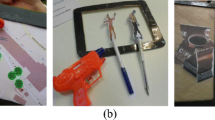Abstract
Mobile services are integrating into the places and routines of daily life. But which types of places afford the use of various services, and how important are these places in our lives? Through several studies, we have explored the types of places that are most important to people in their cities, and compare these to the place types where different location-based services are used. We find that services were used quite consistently between cities, but that between services places of personal salience, such as parks, are less common in the use of today’s check-in services compared with location-based storytelling systems. Supported with data from the StoryPlace.me service, we suggest that focusing on selective sharing and storytelling can facilitate use at these more personally meaningful places.

Similar content being viewed by others
References
Bentley F, Cramer H, Hamilton W, Basapur S (2012) Drawing the city: differing perceptions of the urban environment. Proc. CHI’12
Bentley F, Basapur S (2012) StoryPlace.Me: the path from studying elder communication to a public location-based video service. Ext Abst CHI‘12
Cramer H, Rost M, Holmquist LE (2011) Performing a check-in: emerging practices, norms and ‘conflicts’ in location-sharing using foursquare. Proc. MobileHCI’11
Cranshaw J, Schwartz R, Hong J, Sadeh N (2012) The livehoods project: utilizing social media to understand the dynamics of a city. ICWSM’12
Gehl J (2010) Cities for people. Island Press, Wasington
Goffman E (1959) The presentation of self in everyday life. Anchor Books, New York
Hightower J, Consolvo S, LaMarca A, Smith I, Hughes J (2005) Learning and recognizing the places we go. In UbiComp’05, pp 159–176
Jacobs J (1961) The death and life of great American cities. Vintage Press, New York
Lathia N, Quercia D, Crowcroft J (2012) The hidden image of the city: sensing community well-being from urban mobility. In: Pervasive computing, pp 91–98)
Lindqvist J, Cranshaw J, Wiese J, Hong H, Zimmerman J (2011) I’m the Mayor of my house: examining why people use foursquare, Proc CHI’11
Lynch K (1960) The image of the city. MIT Press, Cambridge
Milgram S (1976) Psychological maps of Paris. Environ-mental psychology: people and their physical settings. Holt, Rinehart and Winston, New York, pp 104–124
Rost M, Barkhuus L, Cramer H, Brown B (2013) Representation and communication: Challenges in interpreting large social media datasets. Proc CSCW’13
Sun A, Valentino-DeVries J, Seward Z (2011) A week on foursquare. http://graphicsweb.wsj.com/documents/FOURSQUAREWEEK1104/. Accessed 20 July 2012
Acknowledgments
We would like to thank Audubon Dougherty for her assistance with the Small Spaces study. We would also like to thank Motorola Labs and the Mobile Life Centre for supporting this research.
Author information
Authors and Affiliations
Corresponding author
Rights and permissions
About this article
Cite this article
Bentley, F., Cramer, H. & Müller, J. Beyond the bar: the places where location-based services are used in the city. Pers Ubiquit Comput 19, 217–223 (2015). https://doi.org/10.1007/s00779-014-0772-5
Received:
Accepted:
Published:
Issue Date:
DOI: https://doi.org/10.1007/s00779-014-0772-5




